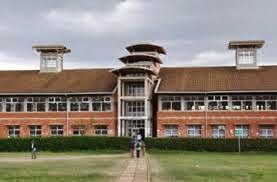 The Technical University of Kenya
grew out of the Kenya Polytechnic. The Kenya Polytechnic be perceived inside
1961 and for quite a while it was the principle association in Kenya that
offered preparing and planning at the tertiary level. The foundations of the
Kenya Polytechnic were complicatedly connected with what today is the
University of Nairobi. Recommendation for the establishment of a Technical
Institute in Nairobi were propelled in the Willoughby Report dispersed in 1949.
This incited the arrangement of the Royal Technical College of East Africa
(RTCEA).
The Technical University of Kenya
grew out of the Kenya Polytechnic. The Kenya Polytechnic be perceived inside
1961 and for quite a while it was the principle association in Kenya that
offered preparing and planning at the tertiary level. The foundations of the
Kenya Polytechnic were complicatedly connected with what today is the
University of Nairobi. Recommendation for the establishment of a Technical
Institute in Nairobi were propelled in the Willoughby Report dispersed in 1949.
This incited the arrangement of the Royal Technical College of East Africa
(RTCEA).
The objective in this was to
construct a Technical College in Nairobi which would offer preparing and planning
at the master and semi-master levels for the three East African areas of Kenya,
Uganda, and Tanganyika. It was then basic that in each of the spaces there
should be understudies adequately qualified to join RTCEA. While Uganda and
Tanganyika made tech¬nical foundations in Kampala and Dar es Salaam to get
prepared contender toward connection RTCEA, Kenya very picked toward there
great gathering streams under the name Kenya Technical In¬stitute (KTI) at
RTCEA.
By 1960 at any rate, it had been
picked that Royal Technical College of East Africa should develop its request
to offer degrees. Thusly in 1960, the RTCEA was yielded the request to offer
degrees of the University of London under an exceptional strategy. Under this
new status, the school had its name changed to the Royal College Nairobi. As
the school had its charge amplified, it was not any more possible to continue
obliging the understudies of the Kenya Technical Institute due to weight on
space. Subsequently the Kenya Technical Institute anticipated that would be
moved to a site of its own. Meanwhile it was seen as that the Diploma ventures
should be moved a long way from RTCEA to Kenya Technical Institute. In this
manner remembering the finished objective to offer excessively planning at the stage
of certificate, the administration tenable the Kenya Polytechnic out of the
Kenya Technical Institute. From its building up, the Kenya Polytechnic promptly
settled itself as a within splendor in the planning of focus level work in the
country. It is seen in the Nairobi CBD reverse the Times Tower and along Haile
Selassie Avenue nearby the City quadrangle Post place of work. It is recognized
for contribution Technical and occupational Education and Training (TVET)
Programs and furthermore the Degree Programs. Among the activities offered at
TU.
In July 2009, the school had the
first gathering of the tasks of study certified by Senate at the University of
Nairobi. The curricula are in the scopes of electrical and electronic outlining
and include the Bachelor of Engineering (B. Eng.) in Electrical and Electronic
Engineering, Bachelor of Technology (B.Tech.) in Electrical and Electronic
Engineering Technology, and the Diploma in Technology (Dip. Tech.) in
Electrical and Electronic Engineering. The ventures are planned to cover
independently five, four, and three years of study for the B.Eng., B.Tech., and
Dip. Tech. The essential partner of degree understudies joined the school in
January 2009 and a portion of whom has subsequent to satisfied the Board of
Examiners and has been proposed for conferment of their specific degrees in the
meeting of 2011. The fundamental assistant of degree understudies joined the
school in January 2009 to study for activities insisted by the University of
Nairobi Senate in the going with districts: The curricula were in the district
of electrical and electronic building and exemplified the Bachelor of
Engineering (B.Eng.) in Electrical and Electronic Engineering, Bachelor of
Technology (B.Tech.) in Electrical and Electronic Engineering Technology and
the Diploma in Technology (Dip. Tech.) in Electrical and Electronic Engineering
Technology. The activities were expected to cover exclusively five, four and
three years of learning for B.Eng. B. Tech. and Di

